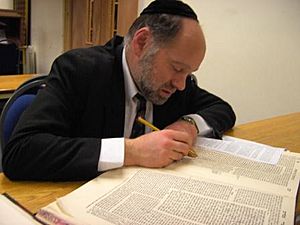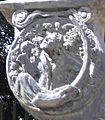Talmud facts for kids
| Part of a series on | |||
|---|---|---|---|
|
|||
| Judaism | |||
| Category | |||
| Jewish religious movements | |||
| Orthodox (Haredi • Hasidic • Modern) | |||
| Conservative • Reform | |||
| Reconstructionist • Renewal • Humanistic | |||
| Jewish philosophy | |||
| Principles of faith • Kabbalah • Messiah • Ethics | |||
| Chosenness • Names of God • Musar | |||
| Religious texts | |||
| Tanakh (Torah • Nevi'im • Ketuvim) | |||
| Ḥumash • Siddur • Piyutim • Zohar | |||
| Rabbinic literature (Talmud • Midrash • Tosefta) | |||
| Religious Law | |||
| Mishneh Torah • Tur | |||
| Shulchan Aruch • Mishnah Berurah | |||
| Kashrut • Tzniut • Tzedakah • Niddah • Noahide laws | |||
| Holy cities | |||
| Jerusalem • Safed • Hebron • Tiberias | |||
| Important figures | |||
| Abraham • Isaac • Jacob | |||
| Moses • Aaron • David • Solomon | |||
| Sarah • Rebecca • Rachel • Leah | |||
| Rabbinic sages | |||
| Jewish life cycle | |||
| Brit • Pidyon haben • Bar/Bat Mitzvah | |||
| Marriage • Bereavement | |||
| Religious roles | |||
| Rabbi • Rebbe • Posek • Hazzan/Cantor | |||
| Dayan • Rosh yeshiva • Mohel • Kohen/Priest | |||
| Religious buildings & institutions | |||
| Synagogue • Beth midrash • Mikveh | |||
| Sukkah • Chevra kadisha | |||
| Holy Temple / Tabernacle | |||
| Jewish education | |||
| Yeshiva • Kollel • Cheder | |||
| Religious articles | |||
| Sefer Torah • Tallit • Tefillin • Tzitzit • Kippah | |||
| Mezuzah • Hanukiah/Menorah • Shofar | |||
| 4 Species • Kittel • Gartel | |||
| Jewish prayers and services | |||
| Shema • Amidah • Aleinu • Kaddish • Minyan | |||
| Birkat Hamazon • Shehecheyanu • Hallel | |||
| Havdalah • Tachanun • Kol Nidre • Selichot | |||
| Judaism & other religions | |||
| Christianity • Islam • Judeo-Christian | |||
| Abrahamic faiths | |||
| Related topics | |||
| Antisemitism • The Holocaust • Israel • Zionism | |||
The Talmud is a very important collection of books in Judaism. It contains many discussions that Rabbis (Jewish teachers) had long ago. These talks are about Jewish law, good behavior, traditions, and history. Jewish people all over the world study and use the Talmud every day. It is a key part of the Jewish religion.
The Talmud has two main parts: the Mishnah and the Gemara.
Contents
What is the Mishnah?
The Mishnah was written down around the year 200 C.E.. It is a collection of the oral laws of Judaism. These laws were passed down by word of mouth for many centuries. The Mishnah helped to organize and preserve these important teachings.
What is the Gemara?
The Gemara was written down later, around the year 500 C.E. It is a deeper discussion of the Mishnah. The Gemara also talks about the writings of the Tannaim (early rabbis) and the Tanakh (the Hebrew Bible). It helps explain and expand on the ideas found in the Mishnah.
Why is the Talmud Important?
The Talmud is like a guide for Jewish life. It helps people understand how to follow Jewish laws and traditions. Studying the Talmud is a big part of Jewish education. It encourages deep thinking and discussion about faith and life. Many Jewish people spend years studying its pages.
Images for kids
-
The first page of the Babylonian Talmud, Tractate Berachot, folio 2a. The center column contains the Talmud text, beginning with a section of Mishnah. The Gemara begins 14 lines down with the abbreviation גמ (gimmel-mem) in larger type. Mishnah and Gemara sections alternate throughout the Talmud. The blocks of text on either side are the Rashi and Tosafot commentaries, printed in Rashi script. Other notes and cross references are in the margins.
See also
 In Spanish: Talmud para niños
In Spanish: Talmud para niños

















